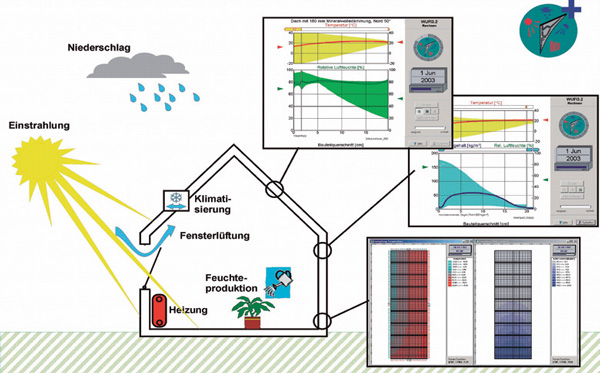Comparison of an air intake/exhaust system with integrated heat recovery and a humidity-controlled ventilation system

In Germany, regulations such as the Energy Saving Ordinance (EnEV) or new laws such as the Usage of Renewable Heat Energy in Baden-Wuerttemberg have been enacted to reduce energy consumption in buildings. New regulations such as these raise the question as to just how efficient different ventilation systems are at reducing energy consumption. With the help of computational tests, a humidity-controlled exhaust air system was examined and compared with an air intake/exhaust system with integrated heat recovery. Researchers evaluated the different ventilation systems using WUFI®-Plus, the newly-developed hygrothermal indoor climate simulation model.
Conducting the research
The tests focused on two systems. One was a humidity-controlled exhaust air system whereby the ventilation is varied according to the relative humidity in the room (also referred to as a demand-based system). The second was a standard air intake/exhaust system with integrated heat recovery and a constant air exchange of 0.4 [KF1] 1/h. A further distinction was made between degrees of efficiency of 80 and 60 percent. If the temperature of the exhaust air was below 1 °C, to avoid condensation-related problems the exterior air was also warmed by a preheating radiator to raise the exhaust air temperature to at least 3 °C. This preheating step must be taken into account when calculating the energy required for ventilation.
For the air intake/exhaust system with heat recovery, the standard procedure is to set the additional air exchange due to infiltration and user behavior to 0.2 1/h (not subject to heat recovery) and to 0.15 1/h for the demand-based exhaust system. To analyze the effect of the humidity-controlled ventilation on the concentration of CO2 in the room, however, the air exchange due to infiltration and user behavior was set to 0.1 1/h in the demand-based system in order to simulate a worst-case scenario.
Comparative calculations between the ventilation systems were carried out based on a 75-m2 model apartment located in the middle of a multi-story residential building. For the outdoor climate, the values of the city of Hof (which has a climate that is colder than average for Germany) were utilized. The indoor temperature was 21 °C and indoor humidity levels were assumed to be those typical of a three-person household. The calculations were carried out for a period of three years. For the heating season of the third year, heat loss through conduction and ventilation was depicted, along with the electrical power required for each ventilation system (according to the manufacturer's specifications). For Hof's climate, the heating season - determined by assuming the heating would be turned on at a threshold of 10 °C - runs from September 15 to May 8 (235 days).
Results
Figure 1 shows the amount of energy required in the model apartment to compensate for heat loss from conduction and ventilation, taking into account the electricity required not only by the ventilation systems but also by the preheating radiator of the air intake/exhaust system with heat recovery. The electricity required by the heating system itself is not taken into account.
Compared to an air intake/exhaust system without heat recovery, a demand-based exhaust system uses 14.6 percent less energy. An air intake/exhaust system with 80 percent heat recovery uses up to 31.2 percent less. As the degree of heat recovery increases, resulting in greater cooling of the exhaust air, the preheating radiator has to be used more.
The difference in total energy requirements for ventilation heating during the heating season is - based on chargeable costs for electricity of €0.19 / kWh and €0.07 / kWh for heating energy (oil or gas) - is given below. This takes into account the fact that the proportion of electricity and heating energy is different for the two ventilation systems. When comparing the demand-based exhaust air system with an air intake/exhaust system, the difference is:
- approx. 650 kWh and thus €30 (with 60 percent heat recovery)
- approx. 1070 kWh and thus €47 (with 80 percent heat recovery).
When viewing these holistically, the investment and maintenance costs of the ventilation systems may also not be forgotten.
When considering the ventilation heat losses and associated primary energy requirements, the energy source in question is a significant factor. Due to the high primary energy factor of 2.7 for electricity - used to operate the ventilation, but also for energy recovery for preheating to prevent ice formation - the electric power consumption plays a decisive role in evaluating the primary energy needs. Whereas the primary energy requirement when utilizing heating oil or natural gas for the ventilation heat is less for an air intake/exhaust system with heat recovery than for a demand-based exhaust system, the requirements are nearly equal when remote heating (local or distant) from cogeneration (PE factor 0.7) is used. From a primary energy perspective, if renewable energy sources such as wood are used, the demand-based exhaust air system has a clear advantage over an air intake/exhaust system with heat recovery. In fact, a higher degree of heat recovery is even a disadvantage because this often entails more preheating and therefore requires more electricity.
Figure 3 shows the progression over time of the CO2 concentration in a three-person household when using the humidity-controlled exhaust air system from September to June, both as hourly values and as a daily moving average. The threshold value of 1200 ppm was only exceeded occasionally. The use of the demand-based exhaust system thus ensures a sufficient air exchange to keep the CO2 concentration below the threshold value.